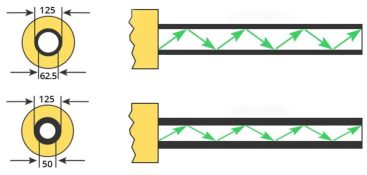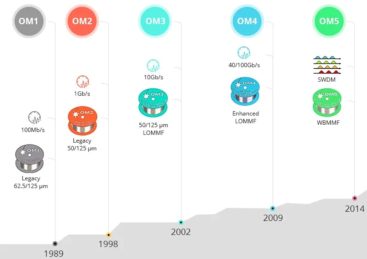OM1, OM2, OM3, OM4 and OM5 multimode fibers
Multimode fiber is a type of fiber used for short-distance transmission, commonly found in campus networks, enterprise LANs, and data centers. Today, the types of multimode fibers on the market are OM1, OM2, OM3, OM4, and OM5, all of which have different data transmission capabilities. With so many types of multimode fibers, do you wonder how to choose? This article will focus on the differences between OM1, OM2, OM3, OM4, and OM5 fibers, and I believe you will have a clearer understanding of the choice of multimode fibers after reading this article.

Types and differences of multimode fibers
Multimode fibers have a larger core diameter, typically 50 μm or 62.5 μm, and support multiple modes of light propagation compared to single-mode fibers, which are classified as OM1, OM2, OM3, OM4 and OM5 fibers according to ISO 11810.
- OM1 optical fiber refers to a multi-mode optical fiber with a bandwidth of more than 200/500MHz.km injected into the 850/1300nm window, which uses LED light source, the core diameter is 62.5μm, and the outer sheath is usually orange, which can be used for Ethernet below 10Gbps, and is most commonly used in 100 Gigabit Ethernet. Due to the large diameter of the OM1 core, it has strong light collection ability and bending resistance.
- OM2 optical fiber refers to a multi-mode optical fiber with a bandwidth of more than 500/500MHz.km injected into the 850/1300nmnm window, which uses LED light source, the core diameter is 50μm, and the outer sheath is usually orange, which can be used for Ethernet below 10Gbps, and is most commonly used in Gigabit Ethernet. Compared with OM1 fiber, OM2 fiber core diameter is reduced, which effectively reduces the mode dispersion of multimode fiber, increases bandwidth, and reduces the production cost by 1/3.
- OM3 fiber is a laser optimized multimode fiber, this kind of fiber uses 850nm VCSEL laser light source, the core diameter is 50μm, and the outer sheath is water blue, which can be used for Ethernet below 100Gbps, and is most commonly used in 10 Gigabit Ethernet. Compared with OM1 and OM2 fibers, OM3 has a higher transmission rate and bandwidth, so it is also called optimized multimode fiber or 10 Gigabit multimode fiber.
- OM4 optical fiber is an upgraded version of OM3 multimode optical fiber, with better performance, for example, the effective bandwidth of OM4 optical fiber is more than double that of OM3 optical fiber, which is compatible with OM3 optical fiber, and the outer sheath is water blue. In Ethernet above 10Gbps, OM4 fiber transmits a longer distance than OM3 fiber, up to 400 meters.
- OM5 fiber is a newly launched bandwidth multimode fiber, which is compatible with OM4 fiber, and its core diameter is the same as OM2/OM3/OM4 fiber (50μm), and the outer sheath is lime green.

All in all, the biggest difference between OM1, OM2, OM3, OM4 and OM5 multimode fibers is the difference in physics and application.
1. Physical differences
Different multimode fibers have different physical differences, which are mainly reflected in the diameter, outer sheath color, light source, and bandwidth, as shown in the following table:
| Multimode fiber type | Diameter | Outer sheath color | Optical source | Bandwidth |
| OM1 | 62.5/125µm | orange | LED | 200MHz*km |
| OM2 | 50/125µm | orange | LED | 500MHz*km |
| OM3 | 50/125µm | Aqua blue | VSCEL | 2000MHz*km |
| OM4 | 50/125µm | Aqua blue | VSCEL | 4700MHz*km |
| OM5 | 50/125µm | Lime green | VSCEL | 28000MHz*km |
2. Application differences
Different multimode fiber applications in different Ethernet networks support different maximum transmission distances, as shown in the following table
| Multimode fiber types | Fast Ethernet | 1G Ethernet | 10G Ethernet | 40G Ethernet | 100G Ethernet |
| OM1 | 2000M | 275M | 33M | / | / |
| OM2 | 2000M | 550M | 82M | / | / |
| OM3 | 2000M | 550M | 300M | 100M | 100M |
| OM4 | 2000M | 550M | 550M | 150M | 150M |
| OM5 | / | / | 550M | 440M | 150M |
Development trend and application of multimode optical fiber
Under the demand of high-speed network applications, multimode optical fiber is developing in the direction of low loss, high bandwidth and multi-wavelength multiplexing. With the continuous improvement of fiber optic technology, multimode fiber has evolved from the original OM1 fiber to the OM5 fiber that now supports 40/100G networks, and its performance is even better. Today, OM1 and OM2 multimode fibers are mostly used for 1G Ethernet link connections in data centers, OM3 and OM4 multimode fibers are mostly used for 10G/40G data center fiber cabling, and OM5 multimode fibers are suitable for 40/100G high-speed Ethernet link transmission. Compared to OM1/OM2/OM3/OM4 multimode fiber, OM5 multimode fiber is highly scalable and flexible, supporting higher network transmission rates with fewer cores, and its cost and power consumption are much lower than that of singlemode fiber. It can be seen that OM5 multimode fiber may be widely used in 100G/400G/1T ultra-large data centers in the future.
Answers to frequently asked questions about multimode fiber
1. What is the difference between multimode fiber and singlemode fiber?
Core diameter: Multimode fibers have a large core diameter (typically 50/62.5μm) and can transmit multiple modes of light. Single-mode fibers have a small core diameter (typically 9 μm) and can transmit only one mode of light. Bandwidth: Single-mode fiber typically has a higher bandwidth than multimode fiber, up to 100,000 GHz. Light source: LED light source is generally used for multimode optical fibers, while laser light sources are generally used for single-mode optical fibers. Distance: Multimode fiber is suitable for short-range applications, typically up to 550m in distance. Single-mode fiber is suitable for long-distance applications, and when the transmission distance is more than 550m, single-mode fiber is preferred. Cost: Multimode fiber is typically less expensive than singlemode fiber.
2. Multimode fiber connector type
At present, common multi-mode optical fiber connectors (i.e., connectors) include ST, SC, FC, LC, MU, E2000, MTRJ, SMA, DIN and MTP&MPO, among which, ST, SC, FC, LC and MTP/MPO are the most commonly used types of optical fiber connectors. The pros, cons, and features of these five fiber optic connectors vary, so what are the differences between them? The following table lists the differences in ferrule size, insertion loss, etc. between ST, SC, FC, LC, and MTP/MPO connectors for multimode fibers
| Multimode Fiber Optic Connectors | Insert Size (Ceramic) | Insertion Loss (dB) |
| SC | φ2.5mm | 0.25~0.5dB |
| LC | φ1.25mm | 0.25~0.5dB |
| FC | φ2.5mm | 0.25~0.5dB |
| ST | φ2.5mm | 0.25~0.5dB |
| MTP/MPO | φ2.5mm | 0.25~0.5dB |
Note: A ferrule refers to a precision-aligned cylinder in a fiber optic connector plug with a microhole in the center that is used to hold the fiber. According to the different materials used in the ferrule, it is divided into ceramic ferrule, glass ferrule, plastic ferrule and metal ferrule.
3. Advantages of multi-mode optical fiber
Despite the advantages of single-mode fiber in terms of bandwidth and transmission distance, multimode fiber can support the transmission distance requirements of most indoor applications and data centers at a fraction of the cost of installation and maintenance. In addition, there are some significant advantages to multimode fiber, as described below:
Multi-user backbone network without loss-free interference: The biggest feature of multimode fiber is that it can carry multiple optical signals on the same link at the same time. What’s more, there is almost no loss of optical signal power. As a result, network users can send multiple packets at the same time in a multimode fiber patch cord, and all the information will be safely transmitted to the destination without any interference and will remain unchanged. Supports multiple protocols: Multimode fiber supports a variety of data transmission protocols, including Ethernet, unlimited bandwidth, and Internet Protocol. As a result, multimode fiber is seen as the foundation for core applications.
4. Can multimode fiber be used as single-mode?
No, because of the large dispersion and loss of multimode fibers, optical signals cannot be transmitted over long distances on multimode fibers.


